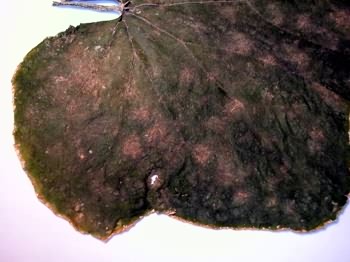Diseases
Erysiphe cichoracearum Dc. f. cucurbitacearum Poteb. - Powdery Mildew of Gourds
Systematic position.
Division Ascomycota, order Erysiphales, family Erysiphaceae, genus Erysiphe.Synonyms.
Erysiphe cucurbitacearum Zheng & Chen, E. orontii (Cast.) GeljutaBiological group.
Obligate parasite.Morphology and biology.
Disease appears mainly on the upper side of leaves and stems, looking like dense white bloom. The affected leaves grow brown, becoming fragile and drying up. The bloom on leaves is a fungal conidial sporification. Sporangia are simple, short, 100-300 mkm in length; conidia are oval, colorless, 36.6 x 20.2 mkm in size, located in chains. By the end of vegetation numerous spherical cleistothetia are formed on the affected leaves, being 80-150 mkm in diameter, having simple short appendages. Each cleistothetium bears to 12 asci being ovoid, 57-77 x 23-28 mkm in size, and having a short peduncle. Ascus has two ellipsoid colorless ascospores of 20-22 x 9-11 mkm. Melon and water-melon are also affected in addition to cucumber.Distribution.
Powdery Mildew of gourd cultures is distributed everywhere in zone of cultures cultivation in open and protected ground. In hothouses the disease is most nocuous in the Central areas of Russia (Ivanovo, Vladimir, Bryansk, Kaluga, Kalinin Regions), in Siberia (Irkutsk, Kemerovo, Chelyabinsk Regions), the Far East (Primorskii Territory and Sakhalin Region) where 93-100% of plants were affected, and the disease development reached 54-75%. In open ground the disease is most nocuous in the Volga Basin region (Samara, Saratov, Nizhnii Novgorod, Volgograd Regions); Northern Caucasus (Krasnodar and Stavropol Territories, Chechnya, Ingushetia, Alania, Kabardino-Balkariya, Kalmykia); Transcaucasia (Armenia, Georgia, Azerbaijan); Moldova; in forest-steppe zone of Ukraine (Zakarpatska, Lviv, Volynska, Rivne, Ternopil, Chernivtsy, Vinnytsya, Khmelnytskyy, Zhytomyr, Kyiv, and other Regions), and in Central Asia (Kazakhstan, Uzbekistan), where yield losses reached 40-100%.Ecology.
Cleistothetia are a source of the infection, being kept on residues of the affected plants and in ground. The optimum temperature for the fungus development is 25-30.S at relative air humidity 80-90% (at 20% humidity the fungus still develops); the incubation period lasts 5-7 days; the fungus can produce 4-5 generations of conidial sporification during a month.Economic significance.
A plant with affected leaves remains undeveloped, small fruits are formed in a small amount. The Powdery Mildew can lower yield of cucumbers by 54-70% in field, and by 100% in hothouses. Control measures are destruction of the vegetation residues; deep autumn plowing; fungicide treatment of plants during vegetation; maintenance of temperature and humidity mode in the protected ground (escaping sharp fluctuations of temperature, excessive humidification, air stagnation).Related references:
Braun U. 1995. The powdery mildews (Erysiphales) of Europe. Jena, Stuttgart, New York, 338 p.Chechuev N.F., Kabirova L.V. 1991. Affection of cucumbers by Powdery Mildew on natural and non-natural infection background. In: Kaliev G.A., ed. Vestnik s.-kh. nauki Kazakhstana. Alma-Ata: Akad. s.-kh. nauk, N 6: 53-55 (in Russian).
Dikanev G.P. 1970. Some ecological features of Erysiphe cichoracearum Dc. In: Dorofeev V.F., ed. Collection of works of post-graduate students and young researchers. Leningrad: VASKHNIL, VIR, V. 17: 320-321 (in Russian).
Kostanyan A.V. 1973. Distribution, nocuity of Powdery Mildew of cucumbers and its control in Armenia. In: Ul.yanishchev V.I., Azaryan G.Kh., Kanchaveli L.A., eds. Materials of the sixth session of the Transcaucasian council on coordination of research works on plant protection (November, 12-15, 1973). Tbilisi: Transcaucasian branch of VASKHNIL, NIIZR MSKH Gruz.SSR, p. 89-90 (in Russian).
Mukhamedov L. 1971. Some questions of biology of Powdery Mildew of cucumbers. In: Vimba E.K., ed. Materials of VII symposium of mycologists and lichenologists of Baltic republics. V. 2. Riga: Latvian GU, Baltic branch of VIZR, Latvian branch of VBO, p. 24-26 (in Russian).
Osnitskaya E.A. 1968. Diseases of vegetables. In: Polyakov I.Ya., Chumakov A.E., eds. Pests and diseases distribution on agricultural crops in RSFSR in 1967 and the forecast of their appearance in 1968. Moscow: Rosselkhozizdat: 120-125 (in Russian).
Osnitskaya E.A. 1969. Diseases of vegetables. In: Polyakov I.Ya., Chumakov A.E., eds. Pests and diseases distribution on agricultural crops in RSFSR in 1968 and the forecast of their appearance in 1969. Moscow: Rosselkhozizdat: 137-144 (in Russian).
Osnitskaya E.A. 1970. Diseases of vegetables. In: Polyakov I.Ya., Minkevich I.I., eds. Pests and diseases distribution on agricultural crops in RSFSR in 1969 and the forecast of their appearance in 1970. Moscow: MSKH RSFSR, VIZR: 252-263 (in Russian).
Osnitskaya E.A. 1971. Diseases of vegetables. In: Polyakov I.Ya., Minkevich I.I., eds. Pests and diseases distribution on agricultural crops in RSFSR in 1970 and the forecast of their appearance in 1971. Moscow: MSKH RSFSR, VIZR: 187-198 (in Russian).
Plekhanova L.P. 1981. Powdery Mildew of cucumbers. Zemlya Sibirskaya Dal.nevostochnaya 5: 27-28 (in Russian).
Pluzhnikova L.E. 1985. Agent of Powdery Mildew of cucumbers. Zashchita rastenii 9: 36-37.
Ragimov U.A. 1957. Powdery Mildew of cucumbers and its control. In: Mekhtiev M.A., ed. Proc. Azerbaijan SKHI, V. 4, series agronomical. Kirovabad: MSKH SSSR, p. 157-161 (in Russian).
Rudenko N. 1967. Powdery Mildew of cucumbers. Kartofel. i ovoshchi 3: 35-36 (in Russian).
Savel.ev V.F., Buyakin D.A. 1977. Influence of sowing time on cucumber affection by Powdery Mildew in irrigation zone of southern Ukraine. In: Zroshuvane zemlerobstvo. Kiev: MSKH Ukr.SSR, Urozhai, V. 22, p. 68-72 (in Ukrainian).
Tabatadze N.A., Akhobadze B.A. 1978. Distribution and materials to study its harmfulness. In: Gvindzhiliya M.B., ed. Proc. NII of agriculture, V. 25. Tbilisi: MSKH Gruz. SSR, p. 150-154 (in Russian).


